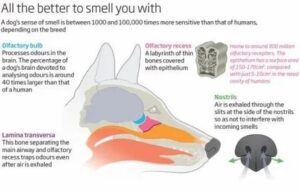
The one thing I see often as people explore detection with their dogs is the sole use of searching. It is better to think of it in three parts.
Olfactory acuity- This involves the mechanical design of the nose, the olfactory epithelium (OE) that odors attach to, the learned behavior of sniffing, and the brain’s ability to process the signal from the OE.
Odor recognition- This is the first step in training young dogs. With reduced environmental difficulty, the dog performs by matching a trained response when in the presence of learned odor sources. This will incorporate associating response with learning, requires memory of both the odor and the correct response, sniffing behavior, understanding of social cues from the handler, and movement between an organized arrangement of containers that might contain an odor source.
Detection search- This is when we engage a dog’s ability to physically and mentally search an area. The difficulty of finding the odor is impacted by environmental stress, avoiding distraction, difficulty of locating odor (variations in height and depth), higher physical exertion that causes the dog to transition from open mouth panting to sniffing, understanding or at least cooperating in an organized search pattern, and in the final phases of training- a nearly unlimited number of areas that could be odor sources.

